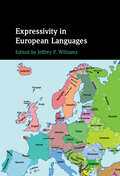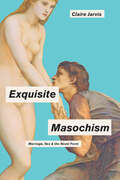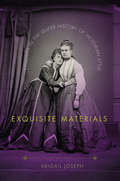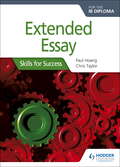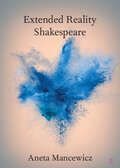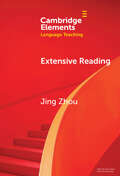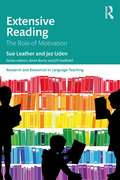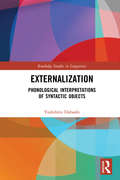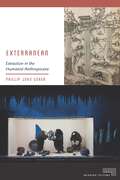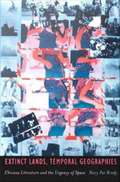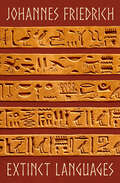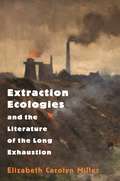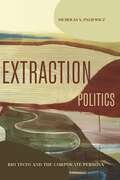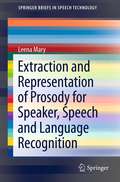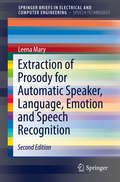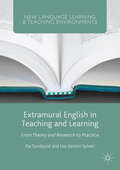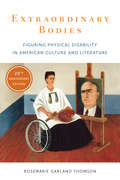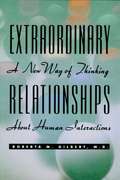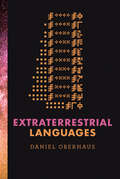- Table View
- List View
Expressivity in European Languages
by Jeffrey P. WilliamsThere is an emerging perspective in the discipline of linguistics that takes expressivity as one of the key components of human communication and grammatical structure. Expressivity refers to the use of grammar in natural languages to convey sensory information in a creative way, for example through reduplication, iconicity, ideophones and onomatopoeia. Expressives are more commonly associated with non-European languages, so their presence in European languages has so far been under-documented. With contributions from a team of leading scholars, this pioneering book redresses that balance by providing copious, detailed information about the expressive systems of a set of European languages. It comprises a collection of original surveys of expressivity in languages as diverse as Hungarian, Finnish, Turkish, Scots, German, Greek, Italian, Catalan, Breton and Basque, all with the common goal of challenging structuralist assumptions about the role of syntax, and showing how expressivity is both typologically diverse and universal.
Exquisite Masochism: Marriage, Sex, and the Novel Form
by Claire JarvisA groundbreaking approach to the Victorian marriage plot.How did realist novelists in the nineteenth and early twentieth centuries hint at sex while maintaining a safe distance from pornography? Metaphors helped: waves, oceans, blooms, and illuminations were all deployed in respectable realist novels to allude to the sexual act, allowing writers to portray companionate marriage while avoiding graphic description. But in Exquisite Masochism, Claire Jarvis argues that some Victorian novelists went even further, pushing formal boundaries by slyly developing scenes of displaced erotic desire to suggest impropriety, perversion, and danger. Through close readings of canonical works by Emily Brontë, Anthony Trollope, Thomas Hardy, and a modernist outlier, D. H. Lawrence, Jarvis reveals how writers’ varied use of specific character types—the dominant woman and the submissive man—in conjunction with decadent, descriptive scenes of sexual refusal creates a strong counter-narrative hinting at relationships beyond patriarchal and companionate marriage structures. By focusing on the exquisitely masochistic pleasure brought about by freezing, or suspending, the sexual charge, and by depicting quasi-contractual states on the periphery of marriage, including engagement, adultery, and widowhood, novelists disrupted the marriage plot’s insistence that erotic drives remain unfulfilled and that sexual connection could be satisfied only by genital act.Complicating our understanding of Victorian marriage ideology’s more well-trodden focus on a productive, nation-building ideal, Exquisite Masochism offers fascinating insight into our own culture’s debates around illicit sexuality, marriage, reproduction, and feminism.
Exquisite Materials: Episodes in the Queer History of Victorian Style
by Abigail JosephExquisite Materials explores the connections between gay subjects, material objects, and the social and aesthetic landscapes in which they circulated. Each of the book's four chapters takes up as a case study a figure or set of figures whose life and work dramatize different aspects of the unique queer relationship to materiality and style. These diverse episodes converge around the contention that paying attention to the multitudinous objects of the Victorian world-and to the social practices surrounding them-reveals the boundaries and influences of queer forms of identity and aesthetic sensibility that emerged in the mid-nineteenth century and have remained recognizable up to our own moment. In the cases that author Abigail Joseph examines, objects become unexpected sites of queer community and desire.
Extended Conceptual Metaphor Theory
by Zoltán KövecsesThe phenomenon known as metaphor is an extremely complex mental event - we cannot capture its complexity if we tie ourselves to existing standard views on metaphor. This book offers fresh insight into metaphor, updating an established theory, conceptual metaphor theory (CMT), in the context of current cognitive linguistic theory, and clarifying many of the issues that researchers in the study of metaphor have raised against conceptual metaphor theory. Starting with an introduction to CMT, the subsequent chapters set out propositions for Extended Conceptual Metaphor Theory, including a discussion on whether literal language exists at all, whether conceptual metaphors are both conceptual and contextual, and whether they are both offline and online. Providing a fresh take on a constantly developing field, this study will enrich the work of researchers in areas ranging from metaphorical cognition to literary studies.
Extended Essay for the IB Diploma: Skills for Success
by Chris Taylor Paul HoangBuild confidence in a range of key essay writing techniques and skills with this practical companion, full of advice and guidance from experienced EE experts.· Build essay writing techniques and skills through a range of strategies, serving as a useful companion throughout the writing process - from the development of a research question, critical-thinking, referencing and citation to reflecting on the process and final essay· Concise, clear explanations help you navigate the IB requirements, including advice on assessment objectives and academic honesty· Learn what is required to get the best EE grades and write an excellent essay with detailed examiner advice and expert tips and hints, including common mistakes to avoid · Explicit reference to the IB Learner profile and the importance of reflection. Paul Hoang is Vice Principal at Sha Tin College, English Schools Foundation in Hong Kong. He writes for Business Review, published by Philip Allan. He is a member of the editorial board for IB Review, Philip Allan's flagship publication for the IB. Paul is the author of several publications including Economics for the IB Diploma Revision Guide (Hodder Education), IB Business Management, 3rd edn (IBID Press), IGCSE Business Studies for Edexcel (Anforme), and Cambridge IGCSE and O Level Economics (Hodder Education). He is an IB examiner and has over 10 years of experience as an IB Workshop Leader.Chris Taylor is Extended Essay Coordinator at Sha Tin College - an international school and IB World School with over 1200 students. He teaches IB History and has examined the EE component of the Diploma for over 10 years. Chris authored Riding the Dragon (2013), a book that details his visits to every province in China and the culture, history and people in each of these. He is a regular contributing author of IB Review magazine, specialising in IB History and the Extended Essay. Having visited many countries, Chris is also a travel writer for the South China Morning Post, Hong Kong's leading English language newspaper.
Extended Essay for the IB Diploma: Skills for Success
by Chris Taylor Paul HoangBuild confidence in a range of key essay writing techniques and skills with this practical companion, full of advice and guidance from experienced EE experts.· Build essay writing techniques and skills through a range of strategies, serving as a useful companion throughout the writing process - from the development of a research question, critical-thinking, referencing and citation to reflecting on the process and final essay· Concise, clear explanations help you navigate the IB requirements, including advice on assessment objectives and academic honesty· Learn what is required to get the best EE grades and write an excellent essay with detailed examiner advice and expert tips and hints, including common mistakes to avoid · Explicit reference to the IB Learner profile and the importance of reflection. Paul Hoang is Vice Principal at Sha Tin College, English Schools Foundation in Hong Kong. He writes for Business Review, published by Philip Allan. He is a member of the editorial board for IB Review, Philip Allan's flagship publication for the IB. Paul is the author of several publications including Economics for the IB Diploma Revision Guide (Hodder Education), IB Business Management, 3rd edn (IBID Press), IGCSE Business Studies for Edexcel (Anforme), and Cambridge IGCSE and O Level Economics (Hodder Education). He is an IB examiner and has over 10 years of experience as an IB Workshop Leader.Chris Taylor is Extended Essay Coordinator at Sha Tin College - an international school and IB World School with over 1200 students. He teaches IB History and has examined the EE component of the Diploma for over 10 years. Chris authored Riding the Dragon (2013), a book that details his visits to every province in China and the culture, history and people in each of these. He is a regular contributing author of IB Review magazine, specialising in IB History and the Extended Essay. Having visited many countries, Chris is also a travel writer for the South China Morning Post, Hong Kong's leading English language newspaper.
Extended Reality Shakespeare (Elements in Shakespeare Performance)
by Aneta MancewiczThis Element argues for the importance of extended reality as an innovative force that changes the understanding of theatre and Shakespeare. It shows how the inclusion of augmented and virtual realities in performance can reconfigure the senses of the experiencers, enabling them to engage with technology actively. Such engagements can, in turn, result in new forms of presence, embodiment, eventfulness, and interaction. In drawing on Shakespeare's dramas as source material, this Element recognises the growing practice of staging them in an extended reality mode, and their potential to advance the development of extended reality. Given Shakespeare's emphasis on metatheatre, his works can inspire the layering of environments and the experiences of transition between the environments both features that distinguish extended reality. The author's examination of selected works in this Element unveils creative convergences between Shakespeare's dramaturgy and digital technology.
Extending the Boundaries of Research on Second Language Learning and Teaching
by Mirosław PawlakThe book contains a selection of papers reflecting cutting-edge developments in the field of learning and teaching second and foreign languages. The contributions are devoted to such issues as classroom-oriented research, sociocultural aspects of language acquisition, individual differences in language learning, teacher development, new strands in second language acquisition research as well as methodological considerations. Because of its scope, the diversity of topics covered and the adoption of various theoretical perspectives, the volume is of interest not only to theorists and researchers but also to methodologists and practitioners, and can be used in courses for graduate students.
Extensive Reading (Elements in Language Teaching)
by Jing ZhouThis Element focuses on extensive reading (ER), a language learning and teaching approach that encourages language learners to read a large amount of interesting and level-appropriate reading materials. Extensive reading has been adopted across educational spectrums, including higher, secondary, and elementary levels, and implemented in diverse language contexts such as English, Chinese, Italian, Spanish, and French. The primary objective of this Element is to offer comprehensive insights into the theoretical foundations of ER, analyze its multifaceted benefits to language learning, address the challenges encountered in its implementation, and propose effective strategies drawn from research for these challenges. The Element concludes with an overview of the latest trends and developments in ER.
Extensive Reading: The Role of Motivation (Research and Resources in Language Teaching)
by Sue Leather Jez UdenExtensive Reading is an innovative resource bridging theory and practice for those seeking to learn about extensive reading (ER) for L2 students' language development, including ways to motivate students to read extensively and to assess learning. Grounded in contemporary theory and the latest research both on ER and motivation, experts Sue Leather and Jez Uden offer a rich array of original activities to help teachers in the classroom and beyond with this effective but difficult-to-implement pedagogical tool. Advanced students, researchers, teacher trainers, and pre- and in-service teachers – and ultimately their students themselves – will benefit from this book.
Externalization: Phonological Interpretations of Syntactic Objects (Routledge Studies in Linguistics)
by Yoshihito DobashiThis book explores theoretical issues of the syntax-phonology interface within the Minimalist Program of linguistic theory and proposes an entirely new approach to prosodic categories. Conceptual as well as empirical questions are addressed, concerning how syntactic objects are mapped to the sensorimotor system through the processes of externalization. Elaborating on recent progress in the theories of labelling and workspace-based syntactic derivation, this book further develops a null theory of the prosodic domains, and recasts these as the domains of interpretation that are reducible to more fundamental concepts of linguistic theory. Phonological phrases are characterized by Minimal Search, a third factor principle of efficient computation. Intonational phrases are taken to be reflexes of the termination of syntactic derivation, which is formulated in terms of the workspace to which MERGE applies. This book explores the new implications this theory has for the general architecture of grammar as well as for linguistic interfaces. It provides a comprehensive review of the development of theories of the syntax-phonology interface from over the past three decades. The book is well-suited for general linguistic readers as well as phonologists, syntacticians, and any linguist interested in interface research.
Exterranean: Extraction in the Humanist Anthropocene (Meaning Systems)
by Phillip John UsherExterranean concerns the extraction of stuff from the Earth, a process in which matter goes from being sub- to exterranean. By opening up a rich archive of nonmodern texts and images from across Europe, this work offers a bracing riposte to several critical trends in ecological thought. By shifting emphasis from emission to extraction, Usher reorients our perspective away from Earthrise-like globes and shows what is gained by opening the planet to depths within. The book thus maps the material and immaterial connections between the Earth from which we extract, the human and nonhuman agents of extraction, and the extracted matter with which we live daily.Eschewing the self-congratulatory claims of posthumanism, Usher instead elaborates a productive tension between the materially-situated homo of nonmodern humanism and the abstract and aggregated anthropos of the Anthropocene. In dialogue with Michel Serres, Bruno Latour, and other interdisciplinary work in the environmental humanities, Usher shows what premodern material can offer to contemporary theory. Examining textual and visual culture alike, Usher explores works by Ronsard, Montaigne, and Rabelais, early scientific works by Paracelsus and others, as well as objects, engravings, buildings, and the Salt Mines of Wieliczka. Both historicist and speculative in approach, Exterranean lays the groundwork for a comparative ecocriticism that reaches across and untranslates theoretical affordances between periods and languages.
Extinct Lands, Temporal Geographies: Chicana Literature and the Urgency of Space
by Mary Pat BradyA train station becomes a police station; lands held sacred by Apaches and Mexicanos are turned into commercial and residential zones; freeway construction hollows out a community; a rancho becomes a retirement community--these are the kinds of spatial transformations that concern Mary Pat Brady in Extinct Lands, Temporal Geographies, a book bringing together Chicana feminism, cultural geography, and literary theory to analyze an unusual mix of Chicana texts through the concept of space. Beginning with nineteenth-century short stories and essays and concluding with contemporary fiction, this book reveals how Chicana literature offers a valuable theoretics of space. The history of the American Southwest in large part entails the transformation of lived, embodied space into zones of police surveillance, warehouse districts, highway interchanges, and shopping malls--a movement that Chicana writers have contested from its inception. Brady examines this long-standing engagement with space, first in the work of early newspaper essayists and fiction writers who opposed Anglo characterizations of Northern Sonora that were highly detrimental to Mexican Americans, and then in the work of authors who explore border crossing. Through the writing of Sandra Cisneros, Cherríe Moraga, Terri de la Peña, Norma Cantú, Monserrat Fontes, Gloria Anzaldúa, and others, Brady shows how categories such as race, gender, and sexuality are spatially enacted and created--and made to appear natural and unyielding. In a spatial critique of the war on drugs, she reveals how scale--the process by which space is divided, organized, and categorized--has become a crucial tool in the management and policing of the narcotics economy.
Extinct Languages
by Johannes FriedrichA noted linguist examines extinct languages, from Egyptian hieroglyphs to the mysteries of as-yet undeciphered writings, in this scholarly work. While certain ancient languages were passed down continuously through the ages, many others were ignored for centuries. When scholars began to decipher these extinct languages in the early nineteenth century, they uncovered previously inaccessible riches of knowledge and history. Yet much work remains to be done on undeciphered scripts that continue to tantalize and perplex us today. In Extinct Languages, linguist Johannes Friedrich guides readers through the fascinating world of recovered systems of writing, including Egyptian and Hittite hieroglyphs, Babylonian cuneiform, and others. He also explains the methodology and principles behind the deciphering process that will one day crack ancient mysteries such as the Indus Valley script.
Extinction and the Human: Four American Encounters (Alembics: Penn Studies in Literature and Science)
by Timothy SweetThe Americas have been the site of two distinct waves of human migration, each associated with human-caused extinctions. The first occurred during the late Pleistocene era, some ten to thirty thousand years ago; the other began during the time of European settler-colonization and continues to this day.In Extinction and the Human Timothy Sweet ponders the realities of animal extinction and endangerment and the often divergent Native American and Euro-American narratives that surround them. He focuses especially on the force of human impact on megafauna—mammoths, whales, and the North American bison—beginning with the moments that these species' extinction or endangerment began to generate significant print archives: transcriptions of traditional Indigenous oral narratives, historical and scientific accounts, and literary narratives by Indigenous American and Euro-American authors. "If the Sixth Extinction is a hyperobject, an event so massively distributed in space and time that it cannot be experienced directly," he writes, "these cases of particular megafauna have nevertheless consistently commanded our focus and attention. They form a starting point for a coherent, approachable history."Reflecting on questions of agency, responsibility, and moral assessment, Sweet engages with the consequences of thinking of humans as fundamentally separate from the rest of the natural world. He investigates stories of a lost race of giants at the time of the first encounters between Europeans and Indigenous Americans; culturally distinct ways of understanding the extinction of the mammoths; the impact of the Euro-American whaling industry and the controversial revitalization of Native American whaling traditions; and the bison's near-extermination at the hands of white market hunters and today's Euro-American and Native American efforts on behalf of the animal's preservation. He reflects on humans' relations with animals through models of divine preservation, competitive extermination, evolutionary determination, biophilia, and treaties with animals. Ultimately, he argues, it is the critical assessment of ideas of human exceptionalism that provides a necessary counterpoint both to apologies for human mastery over nature and deep ecology's attempts to erase the human.
Extraction Ecologies and the Literature of the Long Exhaustion
by Elizabeth Carolyn MillerHow literature of the British imperial world contended with the social and environmental consequences of industrial miningThe 1830s to the 1930s saw the rise of large-scale industrial mining in the British imperial world. Elizabeth Carolyn Miller examines how literature of this era reckoned with a new vision of civilization where humans are dependent on finite, nonrenewable stores of earthly resources, and traces how the threatening horizon of resource exhaustion worked its way into narrative form.Britain was the first nation to transition to industry based on fossil fuels, which put its novelists and other writers in the remarkable position of mediating the emergence of extraction-based life. Miller looks at works like Hard Times, The Mill on the Floss, and Sons and Lovers, showing how the provincial realist novel’s longstanding reliance on marriage and inheritance plots transforms against the backdrop of exhaustion to withhold the promise of reproductive futurity. She explores how adventure stories like Treasure Island and Heart of Darkness reorient fictional space toward the resource frontier. And she shows how utopian and fantasy works like “Sultana’s Dream,” The Time Machine, and The Hobbit offer imaginative ways of envisioning energy beyond extractivism.This illuminating book reveals how an era marked by violent mineral resource rushes gave rise to literary forms and genres that extend extractivism as a mode of environmental understanding.
Extraction Politics: Rio Tinto and the Corporate Persona (RSA Series in Transdisciplinary Rhetoric)
by Nicholas S. PaliewiczAn investigation into one of the largest and most lucrative mineral mining companies in the world, Rio Tinto, Extraction Politics reveals how the company constructs a presence in the places it operates and shapes meanings and orientations toward the environment. Taking readers on a “rhetorical pilgrimage” across the American Southwest, Nicholas Paliewicz shows how Rio Tinto creates adaptable corporate identities. From Ronald Reagan’s frontiersman advertisements for the Borax Mine in California to the pioneer Mormon persona at Bingham Canyon Mine in Salt Lake City and the folksy, paternalistic perspective toward the San Carlos Apache at the proposed mine at Oak Flat, Arizona, the company appropriates local history to embed itself as a valued member of the public—without having to settle in those ecological communities and bear the costs of extraction. This does not occur without resistance, however. Paliewicz also shows how activists use these same tactics to expose Rio Tinto as an exploitative, colonialist polluter.In an era of surging demand for dwindling supplies of minerals and metals, this book previews what the future of extractivism may look like. Extraction Politics will appeal to scholars and students of environmental communication and activist politics as well as general readers interested in the climate crisis.
Extraction and Representation of Prosody for Speaker, Speech and Language Recognition
by Leena MaryExtraction and Representation of Prosodic Features for Speech Processing Applications deals with prosody from speech processing point of view with topics including: The significance of prosody for speech processing applicationsWhy prosody need to be incorporated in speech processing applicationsDifferent methods for extraction and representation of prosody for applications such as speech synthesis, speaker recognition, language recognition and speech recognitionThis book is for researchers and students at the graduate level.
Extraction of Prosody for Automatic Speaker, Language, Emotion and Speech Recognition (SpringerBriefs in Speech Technology)
by Leena MaryThis updated book expands upon prosody for recognition applications of speech processing. It includes importance of prosody for speech processing applications; builds on why prosody needs to be incorporated in speech processing applications; and presents methods for extraction and representation of prosody for applications such as speaker recognition, language recognition and speech recognition. The updated book also includes information on the significance of prosody for emotion recognition and various prosody-based approaches for automatic emotion recognition from speech.
Extramural English in Teaching and Learning
by Pia Sundqvist Liss Kerstin SylvénThis book is unique in bringing together theory, research, and practice about English encountered outside the classroom - extramural English - and how it affects teaching and learning. The book investigates ways in which learners successfully develop their language skills through extramural English and provides tools for teachers to make use of free time activities in primary and secondary education. The authors demonstrate that learning from involvement in extramural English activities tends to be incidental and is currently underutilized in classroom work. A distinctive strength is that this volume is grounded in theory, builds on results from empirical studies, and manages to link theory and research with practice in a reader-friendly way. Teacher-educators, teachers and researchers of English as a foreign language and teachers of English as a second language across the globe will find this book useful in developing their use of extramural English activities as tools for language learning.
Extramural Shakespeare
by Denise AlbaneseThis study argues that Shakespeare can now be understood as part of public culture. Thanks to the emergence of mass education in the twentieth century, Albanese argues that Shakespeare has become a shared property, despite the depiction of his texts as 'elite' cultural objects in the film industry.
Extraordinary Aesthetes: Decadents, New Women, and Fin-de-Siècle Culture (UCLA Clark Memorial Library Series #32)
by Joseph BristowThe fin de siècle not only designated the end of the Victorian epoch but also marked a significant turn towards modernism. Extraordinary Aesthetes critically examines literary and visual artists from England, Ireland, and Scotland whose careers in poetry, fiction, and illustration flourished during the concluding years of the nineteenth century. This collection draws special attention to the exceptional contributions that artists, poets, and novelists made to the cultural world of the late 1880s and 1890s. The essays illuminate a range of established, increasingly acknowledged, and lesser-known figures whose contributions to this brief but remarkably intense cultural period warrant close attention. Such figures include the critically neglected Mabel Dearmer, whose stunning illustrations appear in Evelyn Sharp’s radical fairy tales for children. Equally noteworthy is the uncompromising short fiction of Ella D’Arcy, who played a pivotal role in editing the most famous journal of the 1890s, The Yellow Book. The discussion extends to a range of legendary writers, including Max Beerbohm, Oscar Wilde, and W.B. Yeats, whose works are placed in dialogue with authors who gained prominence during this period. Bringing women’s writing to the fore, Extraordinary Aesthetes rebalances the achievements of artists and writers during the rapidly transforming cultural world of the fin de siècle.
Extraordinary Bodies: Figuring Physical Disability in American Culture and Literature
by Rosemarie Garland ThomsonExtraordinary Bodies is a cornerstone text of disability studies, establishing the field upon its publication in 1997. Framing disability as a minority discourse rather than a medical one, the book added depth to oppressive narratives and revealed novel, liberatory ones. Through her incisive readings of such texts as Harriet Beecher Stowe's Uncle Tom's Cabin and Rebecca Harding Davis's Life in the Iron Mills, Rosemarie Garland-Thomson exposed the social forces driving representations of disability. She encouraged new ways of looking at texts and their depiction of the body and stretched the limits of what counted as a text, considering freak shows and other pop culture artifacts as reflections of community rites and fears. Garland-Thomson also elevated the status of African-American novels by Toni Morrison and Audre Lorde. Extraordinary Bodies laid the groundwork for an appreciation of disability culture and an inclusive new approach to the study of social marginalization.
Extraordinary Relationships: A New Way of Thinking about Human Interactions
by Roberta M. GilbertTurn any Relationship into an Extraordinary Relationship "A refreshing alternative to common self-help approaches. " -Michael E. Kerr, M. D. , Director, Georgetown Family Center, Washington, D. C. and coauthor with Dr. Murray Bowen of Family Evaluation After food, water, and shelter, relationships are the most important factors in determining your quality of life. At work, productivity and efficiency depend on relationships. At home, relationships with your spouse, children, and friends are keys to success and happiness. And among nations, relationships start and stop wars. This invaluable guide shows that only by further developing yourself can you further develop your relationships. Based on the innovative family systems theory pioneered by the late Dr. Murray Bowen, this important and penetrating book offers practical and authoritative family therapy advice that has helped thousands of people throughout the last three decades. It's a blueprint to better relationships that tells how the principles of family systems theory can be used in all arenas of your life, including intimate relationships, friendships, family relationships, single life, workplace relationships, international relationships, and your relationship with yourself. "A perfect and unpretentious primer of family relationships . . . a relief to read. " -Dr. Walter Toman, Professor Emeritus, Erlangen-N8rnberg University, Germany, and author of Family Constellation
Extraterrestrial Languages (The\mit Press Ser.)
by Daniel OberhausIf we send a message into space, will extraterrestrial beings receive it? Will they understand?The endlessly fascinating question of whether we are alone in the universe has always been accompanied by another, more complicated one: if there is extraterrestrial life, how would we communicate with it? In this book, Daniel Oberhaus leads readers on a quest for extraterrestrial communication. Exploring Earthlings' various attempts to reach out to non-Earthlings over the centuries, he poses some not entirely answerable questions: If we send a message into space, will extraterrestrial beings receive it? Will they understand? What languages will they (and we) speak? Is there not only a universal grammar (as Noam Chomsky has posited), but also a grammar of the universe? Oberhaus describes, among other things, a late-nineteenth-century idea to communicate with Martians via Morse code and mirrors; the emergence in the twentieth century of SETI (the search for extraterrestrial intelligence), CETI (communication with extraterrestrial intelligence), and finally METI (messaging extraterrestrial intelligence); the one-way space voyage of Ella, an artificial intelligence agent that can play cards, tell fortunes, and recite poetry; and the launching of a theremin concert for aliens. He considers media used in attempts at extraterrestrial communication, from microwave systems to plaques on spacecrafts to formal logic, and discusses attempts to formulate a language for our message, including the Astraglossa and two generations of Lincos (lingua cosmica).The chosen medium for interstellar communication reveals much about the technological sophistication of the civilization that sends it, Oberhaus observes, but even more interesting is the information embedded in the message itself. In Extraterrestrial Languages, he considers how philosophy, linguistics, mathematics, science, and art have informed the design or limited the effectiveness of our interstellar messaging.
